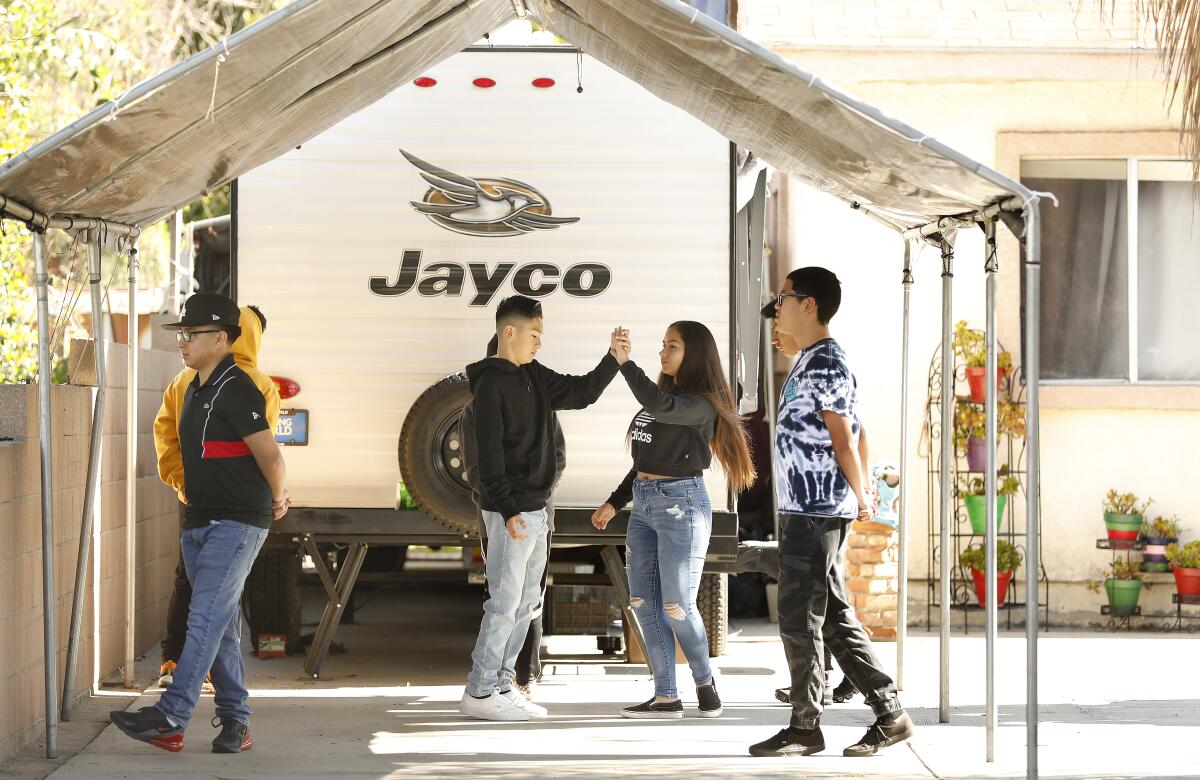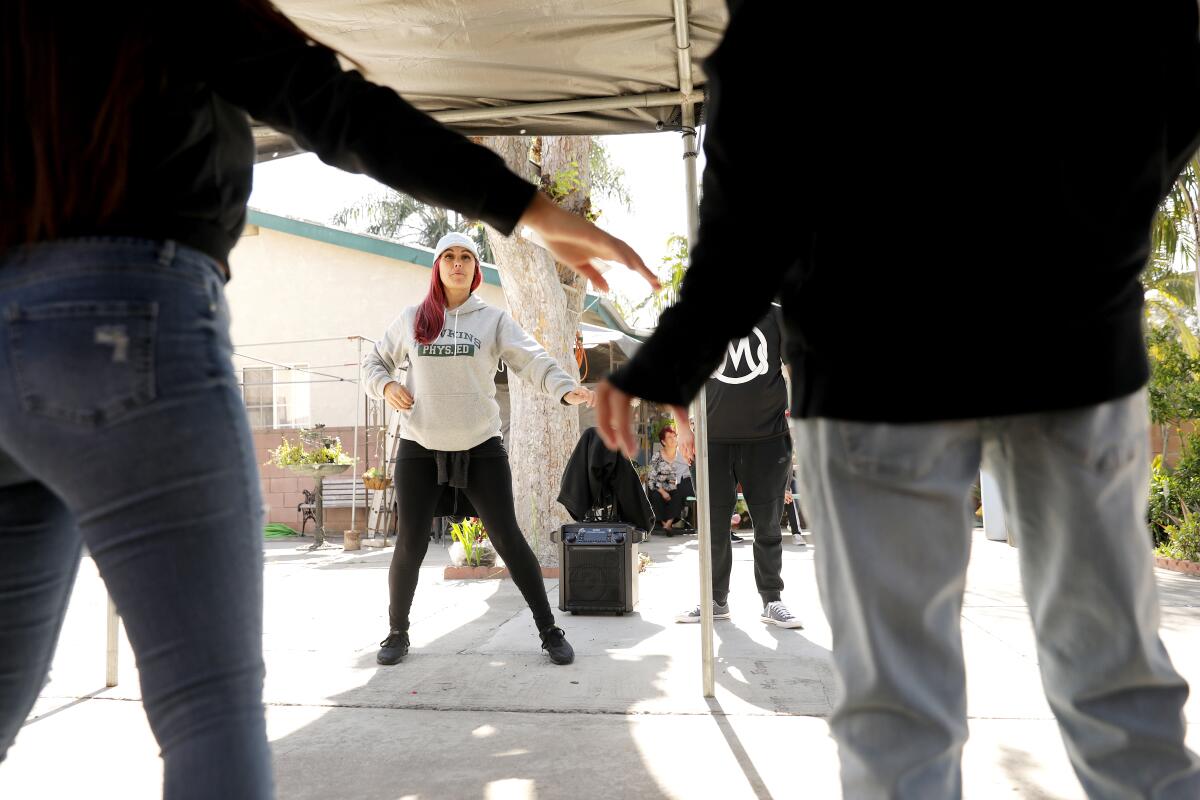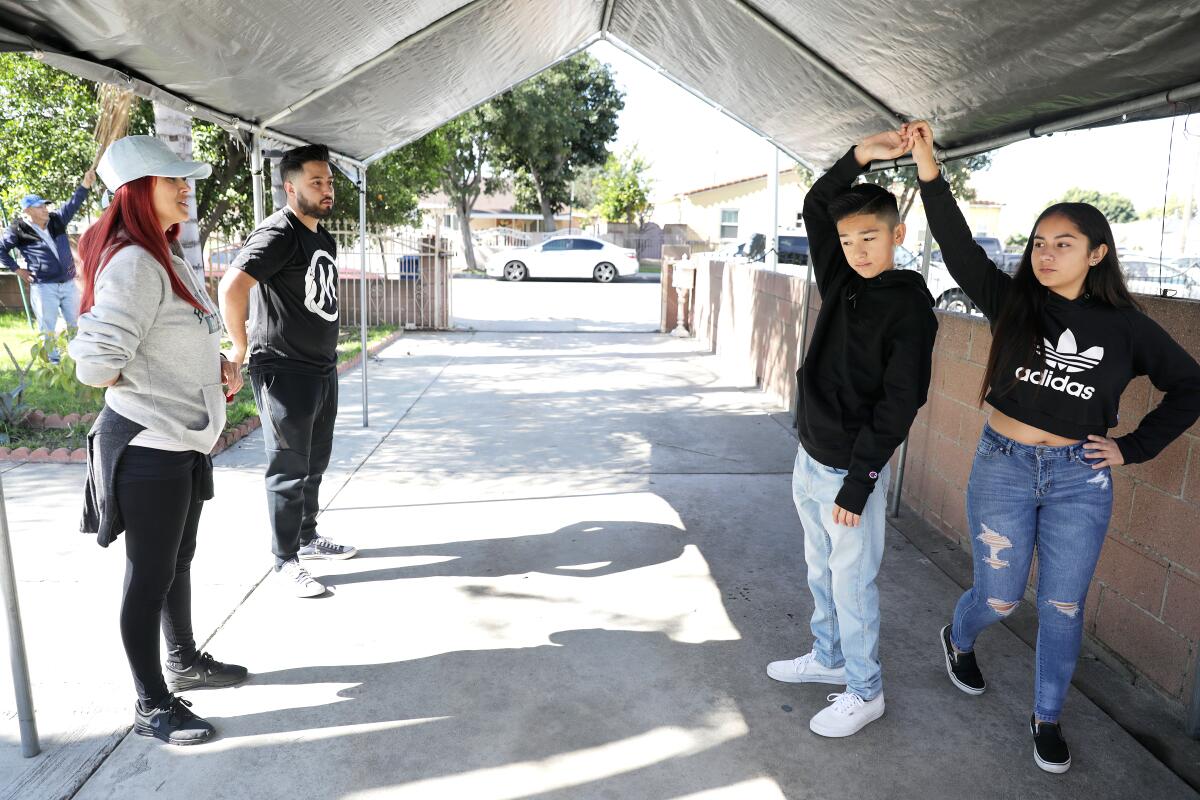The quinceañera is a youthful casualty of the coronavirus

- Share via
If Ashley Soltero had turned 15 in any other year, her quinceañera would have been much, much different.
She wouldn’t have waited to announce the May 2 date to her friends, her escorts — chambelánes — wouldn’t have been nervous about coming to dance practice, and her mother wouldn’t have been laid off in the midst of paying off Ashley’s $2,500 charro-style dress.
But it’s 2020 and COVID-19 has swept the globe. Now it’s a season of lost rituals: prom, grad night, walking across a stage to receive a diploma and, for Latino families in L.A. and beyond, the quinceañera. As unsettling as postponements and cancellations may be for the young, they may be even harder for parents who have invested so much of themselves in their children.
Soltero and her mother, Evelyn Yañez, have been planning her birthday celebration for a year.
“I think she’s more excited, because I’m her only child,” Ashley said. “She wants the best for me, you know?”
A quinceañera is part debutante ball, part coming-of-age ritual with religious overtones. The celebration starts with a Mass. Parents hire photographers, bands and choreographers to make sure the party afterward is perfect. In places with huge Mexican American populations like L.A., quinceañeras are part of the cultural lifeblood of the city and region.
Ashley, who turns 15 on April 8, planned to stick with tradition. She would dance with her father. He would change her shoes from flats to high heels — symbolizing the step into adulthood. She would receive her last doll, a sign of leaving childhood behind.
“It’s a once-in-a-lifetime thing,” Yañez, said. “When you go from being a girl to ...”
“A young lady,” Ashley finished, smiling wide enough to reveal her pink braces.

On Sunday, in hopes that her celebration might go on as planned in May, Ashley practiced dance steps underneath the shade of a gray tarp in her grandparents’ driveway in El Monte. It’s where her mother and her tías practiced for their own quinces decades ago, although now they danced on concrete instead of dirt.
A mariachi version of “Tale as Old as Time,” a song from the film “Beauty and the Beast,” filled the morning quiet that enveloped the neighborhood. The day before, all public and private gatherings had been prohibited anywhere within the jurisdiction of the Los Angeles County Department of Public Health. The dance practice included hand sanitizer and as much distancing as possible.
Yañez had already paid a dance instructor for this second practice. And what if the quinceañera isn’t delayed, she reasoned, and none of her daughter’s quince court know the dance steps? What if the music plays and they just stand there in their elaborate party clothes?
“Five, six, seven, eight,” Cynthia Garcia, a choreographer with My Quince Dances, counted off. “Go one, turn two.”
Only six of the nine chambelánes showed up. One mother asked her son if he was sure he wanted to go, concerned about the coronavirus. Garcia spent most of practice rehashing last week’s steps. If everyone had showed up, they could have practiced new moves, like lifting Ashley.

The girl’s waist-length dark brown hair swayed with each slow turn, the speed chosen to accommodate the ball-gown-like charro dress she would wear the night of her party. For now, she wore a cropped black Adidas sweater and ripped blue jeans. The tarp protected the dancers from the sun beating down that morning.
The chambelán de honor, Ashley’s 11-year-old cousin, rubbed sleep from his eyes before taking her hands in his. The two boys on each side of her pivoted in Vans and jeans. For one, it was his sixth quince as a chambelán. For another, his fourth. A couple of them are in quinces that have been postponed.
Over the past few weeks, Garcia has seen empty quinceañera venues and celebrations postponed after venues have canceled. At a quince on March 14, only half of the invited guests showed up.
“The little girl was really heartbroken,” Garcia said.
Quinceañera celebrations, not dissimilar to weddings, have become a billion-dollar industry, according to some. The average quinceañera costs $21,781, according to the Quinceañera Report. Ashley’s quinceañera is costing around $20,000.
The industry has taken a hit across the country, as state restrictions force families to postpone events indefinitely.

In the Central Valley, one venue allowed a family to reschedule from March 28 to a date in the summer. The only problem? The teenager’s friend was having a separate quinceañera that same day.
“It’s sad for the quince,” choreographer Noemi Ruffin said, referring to the birthday girl, “because now she might have a court without her friends.”
In early March, Ashley grew worried after a friend postponed her quinceañera, and she wondered if she might have to do the same. The teenager has held off on announcing hers for that reason.
“I don’t want to get everyone’s hopes up,” she said.
Still, her family has soldiered on. Ashley is the youngest girl in the immediate family, and this would be the last quinceañera they would celebrate for a long time. They’ve held off on canceling anything for fear of losing their deposits.
Ashley went for a dress fitting in Riverside on Saturday. (To her father’s dismay, she picked out a black dress — although one with yellow, red and blue flowers trailing down the bodice.)
The invitations, which match the teenager’s dress, welcome guests to a fiesta “el 2 de mayo del 2020.” Yañez’s mother told her she needed to send out RSVP cards, because it was unclear who would attend due to “el virus.”
If it happens in May, Ashley’s special day will include a Spanish-language Mass at 2 p.m. and a reception that afternoon. Her family has booked the hall, Mariachi Lindas Mexicanas, and a group to play banda, traditional brass-based Mexican music. By April, Yañez has to pay for food for 300 people.
But now, unexpectedly, she’s also having to apply for unemployment. Last week, she was laid off from a wholesale store for sunglasses where she’d worked since her senior year of high school. Across the state, workers are losing jobs as counties order the closure of nonessential businesses.
“I am stressed and I am worried, but I have that hope. I don’t want to lose that hope that this is all going to be over with,” Yañez said, her hands clasped in her lap. “She’s my only daughter. I want to do everything for her.”
Yañez’s parents tried to do the same for their three daughters. The couple met in El Monte soon after immigrating from Mexico in 1974. They raised their children there.
Her father, Ysidro Yañez, spent 44 years working in a company that made cabinet doors. In Mexico, where his parents were farm workers, there was never enough money to celebrate Christmas. In the U.S., he made sure that all his daughters had a quinceañera.
At Yañez’s quinceañera in Baldwin Park, police had to come because there was so much traffic. She likened it to the lines outside of grocery stores due to panic buying. The hall, which could hold 500, had to close its doors because so many people turned up.
“I’ve always wanted my daughters to have more than what I had,” said Alma Yañez, who is Evelyn’s mother and Ashley’s grandmother. “I think that’s our purpose as parents. We want them to have what we never did.”
For Ashley’s quince, her grandparents are helping pay for the hall, the cake and centerpieces from Mexico — bottles that will be topped with sombreros for her “fiesta Mexicana.” Grandfather and granddaughter will dance together, just as Ysidro danced with his daughters years ago.
As Ashley and her friends danced in the frontyard, her grandfather and another man cut dead palm fronds from a tree. The rest of her family sat nearby and watched the practice.
It was an odd feeling for the teenager, who doesn’t like to be the center of attention. But she took it in stride, her cheeks dimpling with every smile.
The 14-year-old said she worried that her mother was even more stressed out than she was about the possibility of a delay, of this milestone going by unnoticed.
That, she said, hurts most of all.
More to Read
Sign up for Essential California
The most important California stories and recommendations in your inbox every morning.
You may occasionally receive promotional content from the Los Angeles Times.











